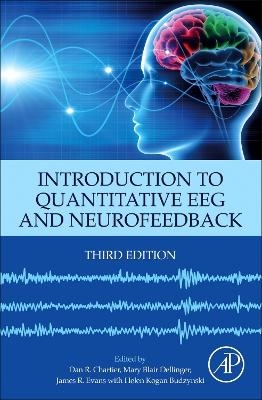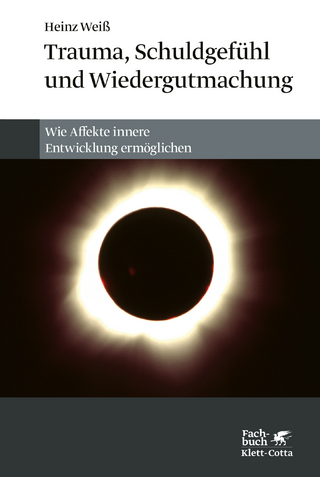
Introduction to Quantitative EEG and Neurofeedback
Academic Press Inc (Verlag)
978-0-323-89827-0 (ISBN)
New chapters on smart-phone technologies and mindfulness highlight their clinical relevance. Written by top scholars in the field, this book offers both the breadth needed for an introductory scholar and the depth desired by a clinical professional.
Dr. Chartier is a licensed psychologist and health service provider. He completed his undergraduate education in psychology and a Master’s degree program in counseling at the University of North Carolina at Chapel Hill. He then earned a Ph.D. degree in psychology from North Carolina State University. He began working with biofeedback in 1983 and in 1989 was an early adopter of neurofeedback and QEEG technology. Dr. Chartier was a founding member of SNR (now ISNR) and served as president in 1999. He was also a founding member of the Society for Advanced Brain Analysis (SABA) and the QEEG Certification Board (now the International QEEG Certification Board) serving as IQCB chairperson 2016 - 2018. Dr. Chartier is also a board member for the Southeastern Biofeedback and Clinical Neuroscience Association. His academic service has included a clinical associate professorship in the Psychiatry Department, UNC-CH School of Medicine. Dr. Chartier provides an annual lecture on QEEG, neurofeedback and biofeedback for the UNC-CH School of Medicine Complementary and Alternative Medicine Program. His recent publications include a chapter in Alpha-Theta Neurofeedback in the 21st Century: a handbook for clinicians and researchers and a chapter in The First 50 Years of Neurofeedback. Mary Blair Dellinger is a Licensed Professional Counselor in the state of South Carolina. She completed her Masters in Professional Counseling at Liberty University. A graduate of Psychology and Neuroscience from the University of South Carolina in Columbia, Dellinger is BCIA Board Certified in neurofeedback. She has eight years experience conducting neurofeedback sessions with adults and children. She has specialized training in use of advanced procedures such as LORETA neurofeedback and NeuroGuide Software and BCIA certification in Heart Rate Variability (HRV) biofeedback. She is both an ISNR member and a Magellan Scholar. Editor of recent publication Neurofeedback: The First Fifty Years. Dr. James Evans is licensed in clinical and school psychology. Following graduation with a bachelor's degree in education, and a tour of duty in the U.S. Army, he taught in a public high school. Later he earned a master's degree in psychology. After working for six years at a state hospital and a county mental health center, he attended Peabody College of Vanderbilt University where he received a Ph.D. degree in psychology. He was on the faculty of the Psychology Department at the University of South Carolina for thirty years, and is retired from that position. He has completed postdoctoral work in neuropsychology at the University of California at San Francisco, the University of Georgia and the Medical College of Georgia. For over thirty years he also has maintained a successful private practice involving working with children and adults in hospital, school, prison, and private office settings. He has expertise in psychological, neuropsychological and psychoeducational assessment, as well as years of experience in psychotherapy and neurotherapy. He is the author of thirty-five journal articles and nine book chapters, and editor or co-editor of ten psychology-related books, including Rhythmic Stimulation Procedures for Neuromodulation (2017) and Neurofeedback: The First Fifty Years ( 2019). Presently he is self-employed as a psychologist at the Sterlingworth Center in Greenville, SC. Helen Kogan Budzynski worked in the Department of Psychosocial and Community Health at the University of Washington School of Nursing, Seattle, WA, United States.
Section I. Raw EEG and QEEG and NFB Foundational Concepts 1. Electroencephalography microstates in relation to emotional decision-making 2. Quantitative electroencephalography clinical applications: A review and update 3. Electroencephalography imaging and biofeedback training using Z-Scores: databases and LORETA-based methods 4. Autonomic nervous system and the triple network: An evolutionary perspective with clinical implications 5. Taking a deeper look into the wiring of baby humans 6. When can you trust your beta: Detecting electromyography contamination of the electroencephalogram signal to enhance assessment of quantitative electroencephalogram and electroencephalogram training 7. Origins of electroencephalogram rhythms and implications for neurofeedback 8. History of the scientific standards of quantitative electroencephalography normative databases 9. Electroencephalogram neuroimaging, brain networks and neurofeedback protocols 10. Electroencephalogram in depth: Seeing psyche in brainwaves 11. Theories of brain functioning and the quantitative electroencephalography
Section II. Clinical Applications of NFB 12. Multiple channel advanced standardized weighted low-resolution electromagnetic tomography training for sustained clinical outcome 13. Utilizing quantitative electroencephalographic Assessment and standardized low-resolution brain electromagnetic tomography neurotherapy in the treatment of trauma and dissociation 14. Neurofeedback and developmental trauma: Theory and practice 15. Advances in analysis and training 16. The importance of contingency between electroencephalographic patterns and neurofeedback for sustained clinical outcome 17. Endogenous neuromodulation at infra-low frequencies 18. Neurofeedback in elite and athlete performance 19. Application of electroencephalogram and other neurophysiological measures in assessment of cue-reactivity in individuals with substance use disorder 20. Quantitative electroencephalogram, event-related potential and neurofeedback in substance use disorders research and treatment 21. Asperger’s syndrome intervention: Combining neurofeedback, biofeedback and metacognition 22. Effective intervention for attention-deficit/hyperactivity disorders using quantitative electroencephalography and neurofeedback 23. Alpha–theta neurotherapy and the neurobehavioral treatment of addictions, mood disorders, and trauma
Section III. Complementary Approaches and Adjunctive Concepts for Neuromodulation and NFB 24. Midstream exchange between the gastrointestinal system and the brain 25. pIR HEG neurofeedback and nIR HEG neurofeedback, best practices 26. “Wearables: A new age of personal empowerment 27. Optimal biofeedback: Combining neurofeedback and integrative neuromodulation through light, sound, vestibular/cerebellar stimulation and heart rate variability 28. Music and neuromodulation 29. Physiology of audio-visual entrainment technology 30. Lifestyle and environmental influences on electroencephalography, quantitative electroencephalography, and Neurofeedback
Section IV. Ethical and Legal Issues 31. Quantitative electroencephalography goes to court - Applications in liability and capital cases 32. Ethical principles in neurofeedback standards of care and clinical practice
| Erscheinungsdatum | 02.03.2023 |
|---|---|
| Verlagsort | Oxford |
| Sprache | englisch |
| Maße | 216 x 276 mm |
| Gewicht | 1860 g |
| Themenwelt | Geisteswissenschaften ► Psychologie ► Allgemeine Psychologie |
| Geisteswissenschaften ► Psychologie ► Biopsychologie / Neurowissenschaften | |
| Geisteswissenschaften ► Psychologie ► Klinische Psychologie | |
| Geisteswissenschaften ► Psychologie ► Verhaltenstherapie | |
| Medizin / Pharmazie ► Medizinische Fachgebiete ► Neurologie | |
| Naturwissenschaften ► Biologie ► Humanbiologie | |
| Naturwissenschaften ► Biologie ► Zoologie | |
| ISBN-10 | 0-323-89827-0 / 0323898270 |
| ISBN-13 | 978-0-323-89827-0 / 9780323898270 |
| Zustand | Neuware |
| Haben Sie eine Frage zum Produkt? |
aus dem Bereich


